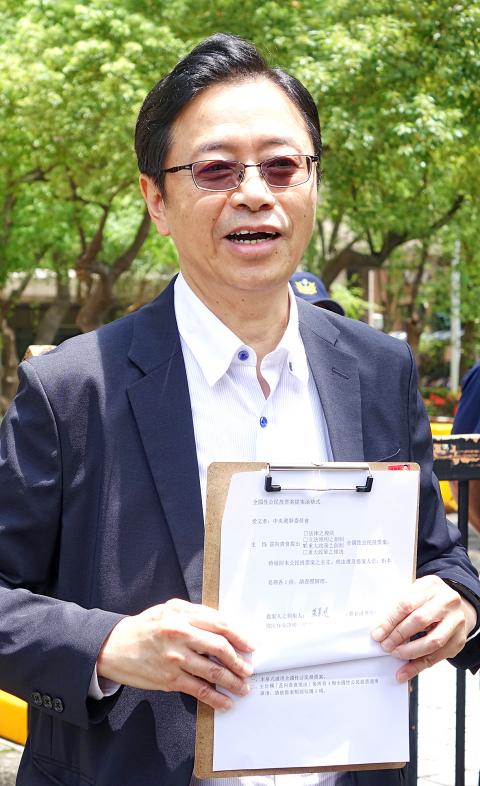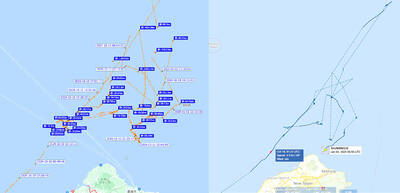Former premier Simon Chang (張善政) yesterday unveiled the “digital nation” referendum he is sponsoring and delivered 2,500 signatures to the Central Election Commission.
The proposed referendum hopes to establish an innovative digital committee or bureau, or similar agency, as part of the Executive Yuan to further develop the nation’s digital capabilities, said Chang, who last month announced his intention to run in next year’s presidential election as an independent candidate.
The government would, by law, have to establish laws and implement the agency should the referendum pass, Chang said, adding that should he win the presidential election, he would establish such an agency as his first executive order.

Photo: Liu Hsin-de, Taipei Times
The next challenge is to obtain the 300,000 signatures to make the referendum a reality, Chang said, adding that the primary problem — and also the most time and resource-consuming — would be how to collect the signatures.
Chang’s solution is to work with a taxi fleet and ride-hailing app — possibly Taiwan Taxi and Uber — to collect and organize the signatures.
The referendum’s primary purpose is to make Taiwan a digitally and technologically robust nation, Chang said.
He called the referendum the “Digital May Fourth Movement.”
The May Fourth Movement was a student-led movement calling for democratization, further scientific studies and discontent about the “Shandong Issue” under the nascent Republic of China government in 1919.
The “Shandong Issue” referred to the perceived inability of the government to protect China’s national interests such as the Treaty of Versailles handing Japan territories in Shandong, which had been surrendered by Germany after the Siege of Tsingtao in 1914.
Chinese academic and philosopher Hu Shih (胡適) had wished for wide-spread education in China a century ago, Chang said, adding that he hoped his “movement” would spur Taiwanese to have a deeper understanding of technology.
Chang said that he would be forming a nonpartisan Digital Legislators’ Association that would accept any candidate running for a legislative seat who recognizes that the government must implement structural changes to keep up with the digital age.

A strong continental cold air mass and abundant moisture bringing snow to mountains 3,000m and higher over the past few days are a reminder that more than 60 years ago Taiwan had an outdoor ski resort that gradually disappeared in part due to climate change. On Oct. 24, 2021, the National Development Council posted a series of photographs on Facebook recounting the days when Taiwan had a ski resort on Hehuanshan (合歡山) in Nantou County. More than 60 years ago, when developing a branch of the Central Cross-Island Highway, the government discovered that Hehuanshan, with an elevation of more than 3,100m,

Taiwan’s population last year shrank further and births continued to decline to a yearly low, the Ministry of the Interior announced today. The ministry published the 2024 population demographics statistics, highlighting record lows in births and bringing attention to Taiwan’s aging population. The nation’s population last year stood at 23,400,220, a decrease of 20,222 individuals compared to 2023. Last year, there were 134,856 births, representing a crude birth rate of 5.76 per 1,000 people, a slight decline from 2023’s 135,571 births and 5.81 crude birth rate. This decrease of 715 births resulted in a new record low per the ministry’s data. Since 2016, which saw

SECURITY: To protect the nation’s Internet cables, the navy should use buoys marking waters within 50m of them as a restricted zone, a former navy squadron commander said A Chinese cargo ship repeatedly intruded into Taiwan’s contiguous and sovereign waters for three months before allegedly damaging an undersea Internet cable off Kaohsiung, a Liberty Times (sister paper of the Taipei Times) investigation revealed. Using publicly available information, the Liberty Times was able to reconstruct the Shunxing-39’s movements near Taiwan since Double Ten National Day last year. Taiwanese officials did not respond to the freighter’s intrusions until Friday last week, when the ship, registered in Cameroon and Tanzania, turned off its automatic identification system shortly before damage was inflicted to a key cable linking Taiwan to the rest of

China’s newest Type-076 amphibious assault ship has two strengths and weaknesses, wrote a Taiwanese defense expert, adding that further observations of its capabilities are warranted. Jiang Hsin-biao (江炘杓), an assistant researcher at the National Defense and Security Research, made the comments in a report recently published by the institute about the Chinese Communist Party’s (CCP) military and political development. China christened its new assault ship Sichuan in a ceremony on Dec. 27 last year at Shanghai’s Hudong Shipyard, China’s Xinhua news agency reported. “The vessel, described as the world’s largest amphibious assault ship by the [US think tank] Center for Strategic and International